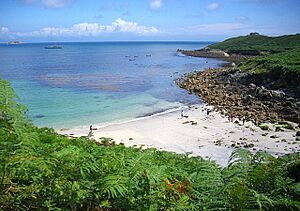Watermill Cove facts for kids
Watermill Cove is a beautiful bay located on the northwest coast of St Mary's island, which is part of the Isles of Scilly. This small, sheltered cove has been used for a very long time by boats looking for a safe place to stop. Even today, you'll see yachts and other small ships anchoring here.
At a spot called Tregear's Porth, you can still see parts of an old quay, which is like a dock where boats used to load and unload. The slipway, a ramp for launching small boats into the water, is still in use today.
Contents
A Special Place for Nature
Watermill Cove is not just pretty; it's also very important for nature and science. It's part of an Area of Outstanding Natural Beauty, which means its landscape is protected because it's so special.
Protecting the Land
The cove is also a Geological Conservation Review site. This means it's recognized as a key place to study Earth's history through its rocks and landforms. In 1996, Watermill Cove was named a Site of Special Scientific Interest (SSSI). This is a special title given to places in the UK that have rare wildlife, plants, or geological features. The SSSI here covers about 0.48 hectares (just over an acre).
Earth's History in the Cliffs
The cliffs at Watermill Cove are like an open book, showing layers of Earth's past. Scientists can study these layers, called "exposures," from the bottom of the cliff all the way to the top. These layers tell us about different periods in Earth's history, especially the Quaternary period, which includes the most recent ice ages.
Layers of Time
From the oldest layers at the bottom to the newest at the top, the cliffs show:
- Head deposits: These are layers of broken rock and soil that have moved down hillsides, often due to freezing and thawing.
- Organic silts and sands: These layers contain fine soil and sand, along with materials from ancient plants and animals.
- Late Devensian head deposits: These layers are from a very cold time, about 30,000 years ago, during the last major Ice Age. Scientists have found tiny plant pieces and pollen here, which tell us that the climate was like the Arctic tundra back then. This means it was extremely cold and treeless.
- Raised beach deposits: These are old beach layers that are now higher than the current sea level. They include a "storm beach" from the Late Ipswichian interglacial period. An interglacial period is a warmer time between two ice ages. This particular warm period happened about 130,000 years ago and ended around 114,000 years ago. These layers show how sea levels and climates have changed dramatically over thousands of years.


